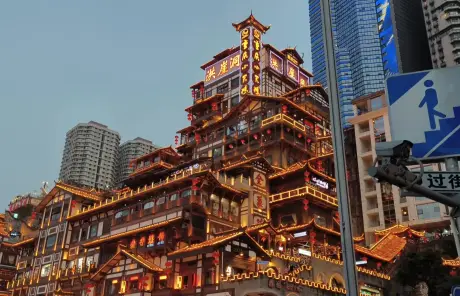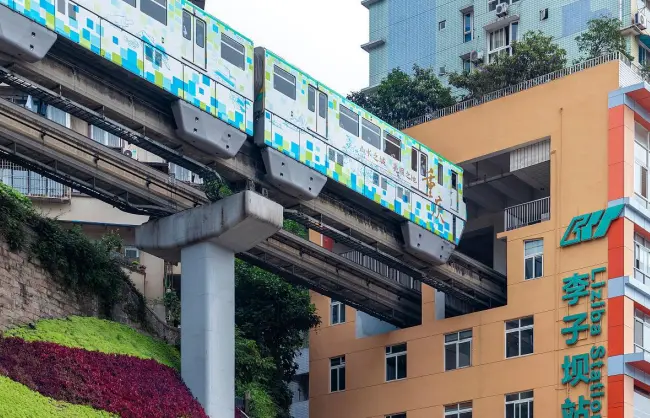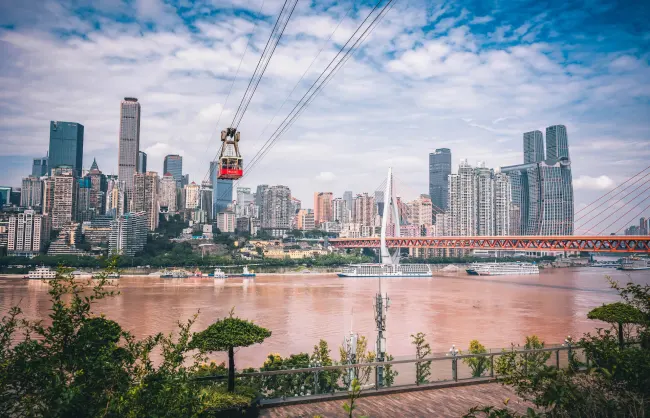Chongqing Travel Guide – Explore Unique Charm of the Mountain City
Located on the eastern edge of the Sichuan Basin, Chongqing borders the Daba Mountains and Wuling Mountains to the south and north, and shares borders with Hubei, Hunan, Sichuan, Guizhou, and Shaanxi in different directions. This mega-city is built on mountainous terrain and encircled by the Yangtze and Jialing Rivers, being endowed with a unique geographical and urban landscape. That’s why it is widely called the “Mountain City” and “River City”.
For most travelers, the top reasons to travel to Chongqing always include the unparalleled natural wonders to see on a scenic Yangtze River cruise and Chongqing’s appetizing hotpot, noodles, and many other spicy dishes. While, please note that, the natural bridges in its Wulong Karst Landscape are also impressive. Chongqing’s profound history also left the city with a wealth of historical and cultural sites, including Ciqikou Ancient Town, Dazu Rock Carvings, and Hongya Cave.
Our ultimate Chongqing Travel Guide is for you to discover more highlights of this megacity in the upper reaches of the Yangtze River and help you plan your perfect Chongqing tour.

Chinese: 重庆
Location: Southwest China, in the upper reaches of the Yangtze River
Population (urban area): 31,914,300
Why Visit Chongqing?
- An important starting/ending point for the Yangtze River cruise: Located in the upper reaches of the Yangtze River, Chongqing is the ideal starting/ending point for a scenic Yangtze River cruise. The cruise allows visitors to enjoy a comfortable travel experience while cruising down the Yangtze River and closely appreciating one of China’s most popular natural attractions.
- A culinary paradise: Chongqing hotpot is broadly popular across the country for its spicy and flavorful tastes. Besides that, Chongqing also attracts foodies with its Chongqing noodles, mapo tofu, etc.
- Distinctive urban planning: The mountainous terrain results in Chongqing’s unique multi-level urban landscape. Light rail trains passing through buildings, and the riverside Hongya Cave are just some examples of its magical urban scenery.
- Rich culture and history: Boasting a history of over 3,000 years, a Chongqing tour will also reward you with many historical and cultural sites, including Dazu Rock Carvings, Ciqikou Ancient Town, and Three Gorges Museum.
- Dazzling nightscape: Chongqing’s nightscape, alongside Hong Kong‘a Victoria Harbor and Shanghai’s Bund, boasts one of the top three night views in China. Its amazing skyline, mountainous terrain, historical buildings, and the confluence of two rivers together create the unparalleled night scene of Chongqing.
Top Attractions in Chongqing
Top Chongqing Attractions along the Yangtze River
The Yangtze River of the Chongqing section is home to some of the most magnificent natural wonders in China and many historical sites. The scenic Yangtze River cruise is the best way to marvel at all these marvels at a leisurely pace. During the cruise, several shore excursions are arranged to allow you a more immersive exploration of these attractions.
Three Gorges
Located in the heart of China along the Yangtze River, the Three Gorges comprise Qutang Gorge, Wu Gorge, and Xiling Gorge, each of which is celebrated for its unique but extraordinary natural and cultural wonders.
Fengdu Ghost City
With a history of over 2,000 years, Fengdu Ghost City offers a glimpse into ancient Chinese imaginings and understandings of the netherworld. It houses 27 ancient temples and shrines illustrating concepts of the afterlife and recreating many stories about "ghosts".
Shibaozhai Pagoda
An iconic landmark along the northern bank of the Yangtze River, Shibaozhai is an ancient architectural complex that was ingeniously integrated into the steep cliff. The twelve-story wooden pagoda is its top highlight, with the entire building being constructed using traditional wooden beam and column structures.
White Emperor City
A witness to many famous historical events from the Han Dynasty to the Ming and Qing Dynasties, the White Emperor City offers a glimpse into the essence of Three Kingdoms culture and many well-preserved buildings. Plus, its excellent location makes it a great place to admire the stunning Qutang Gorge and Kui Gate.
Recommended Attractions in and around Chongqing City Area
Besides natural marvels along the Yangtze River, there are also rich natural and cultural attractions in and around the Chongqing city area. Additionally, as a city built on the mountains and blessed with several major rivers, the city itself is charming enough for visitors, with its distinctive multi-level transportation system and layered street layout.
Top Things to Do in Chongqing
Ride the Yangtze River Cableway
Want a skyline adventure in Chongqing? Then, the Yangtze River Cableway should be your ideal choice. A unique aerial travel experience, the cableway ride will not only offer a stunning panoramic view of Chongqing’s breathtaking cityscape, but also the magnificent meeting of the Yangtze and Jialing Rivers, and the bustling river traffic. A night ride on the cableway is particularly charming when the colorful lights decorate the city into a dazzling world.
Witness Light Rail Passing Through Buildings
To adapt to the complicated mountainous terrain, Chongqing has designed its transportation system in an innovative way. Liziba Light Rail Station on Line 2 is one of the most famous examples of its unique transportation design. Here you can witness the light rail train precisely navigate through the 6th to 8th floors of a high residential building.

Taste Chongqing Hotpot
Hotpot is a culinary symbol of Chongqing, known nationwide for its spicy and flavorful tastes. To experience Chongqing’s daily life by food, the hotpot is thus a can’t-miss. The broth is the essence of Chongqing hotpot which is typically made from beef tallow, peppercorns, and dried chili peppers. While dining, people will order and cook a variety of ingredients in the broth on-site. And, you can personalize a dipping sauce based on your preference and dip the cooked ingredients in the sauce to enhance the flavor. Read more Top 10 Food to Eat in Chongqing
Take a Leisure Stroll at Jiefangbei Pedestrian Street
A commercial area where locals usually shop and dine is always an ideal place to feel a deeper connection to the places you visit. When having a trip to Chongqing, Jiefangbei Pedestrian Street is just this kind of commercial area, housing many shopping centers, food stalls, and restaurants. The famous Bayi Road Food Street is adjacent to it, offering a variety of authentic Chongqing foods.
Recommended Chongqing Tours
Chongqing Weather & Best Time to Go
Chongqing enjoys a typical subtropical monsoon humid climate, featuring high humidity and distinct seasons. Because of the frequent fog in Chongqing, it is widely known as the “Fog City”. The city can see about 104 foggy days each year on average, which is even more than London and Tokyo.
Summers in Chongqing are hot and humid, and July and August are especially scorching, with the daily maximum temperatures often exceeding 35°C, and even surpassing 40°C on some days. This is also the period when heavy rains often occur. But summer is a good time if you want to experience the city’s bustling nightlife.
Winters in Chongqing are not that cold when the average temperature hovers around 10°C. While, since foggy days are frequent in this season, winter is not a great time if you want to enjoy a stunning panoramic view of the city’s skyline and the two rivers.
The best time to visit Chongqing is during spring and autumn as the temperatures are typically moderate and the sunshine is abundant. Both of these two seasons are ideal for outdoor activities and enjoying flowers or colorful foliage.
Chongqing Transportation: How to Get to & Travel Around
How to Get to Chongqing?
By Air:
Chongqing Jiangbei International Airport is the main airport serving Chongqing and is located about 25 kilometers from the city center. It operates numerous flights connecting most major domestic cities and several international cities. From the airport, visitors can easily reach the city center by airport shuttle bus, metro (Line 3 and Line 10), or taxi.
By Train:
High-speed train is also a convenient way to get to Chongqing. Chongqing North Railway Station, Chongqing West Railway Station, and Shapingba Railway Station are the three major train stations serving high-speed trains in Chongqing. The north railway station is more chosen for its closer distance from the city center. Visitors can reach Chongqing fast and easily by high-speed trains from many domestic cities.
If plan to travel to Chongqing from nearby destinations, like Xian, Chengdu, and Changsha, high-speed or bullet trains are more convenient compared to flights. The journey will take about 2-5 hours and can save you from the long commute between the city center and the airport.
How to Travel Around Chongqing?
Chongqing has a developed transportation system that allows visitors to travel around and navigate its major attractions easily. More than the common transportation options like subway, bus, and taxi, the city also offers some unique options to cater to its specific geographical features. These unique transit means include the Yangtze River Cableway and ferries connecting both sides of the Yangtze River, and the “Crown Escalator” at Lianglukou in Nanshan.
Currently, there are 12 rail transit lines serving Chongqing’s main urban area, placing it among the ranks of the largest mountain city rail transit system in the world. The rail transit system in Chongqing includes both light rail and metro lines and is one of the most efficient ways to reach popular attractions, such as Hongya Cave, Ciqikou, Yangtze River Cableway, Nanshan Yikeshu Viewing Platform, etc. To reach destinations not along the rail lines, its extensive bus network can take you to every corner of the city.
To get to Dazu Rock Carvings from Chongqing, the top recommended option is to take a private car which will take no more than 2 hours. This can also save you the hassle of finding the right bus/train stations on both sides. We also offer a private vehicle service with an English-speaking guide included. Please feel free to contact us for vehicle booking or other information inquiries.

Accommodation in Chongqing: Where to Stay
As a megacity, Chongqing offers a diverse range of options of different styles and standards, from unique homestays and budget hotels to luxury and international hotel chains. Generally, prices for budget and three-star hotels in Chongqing range from CNY 100-500 per night, varying depending on the location. To book a 4 or 5-star Chongqing hotel, the price is about CNY 400 to over CNY 1,000 per night.
Regarding the accommodation areas, hotels around the Jiefangbei Pedestrian Street are top recommended for their variety of hotel and entertainment options and easy access to Hongya Cave, Chaotianmen, and the Yangtze River Cableway. Shapingba District – home to Chongqing Zoo, and Nan’an District with great spots for stunning night views of the city and the Yangtze River are also recommended accommodation areas. As hotels in these two districts are generally more affordable than Jiefangbei, and offer convenient transportation.









